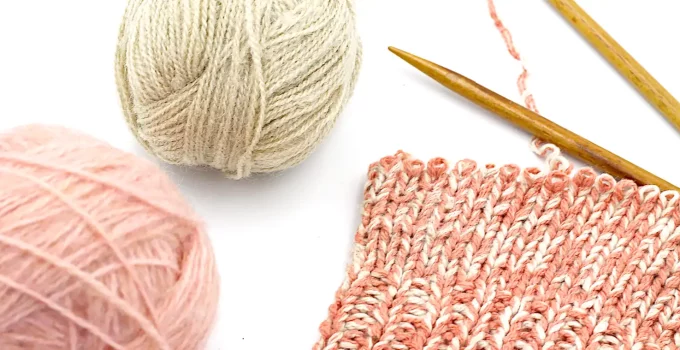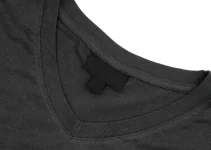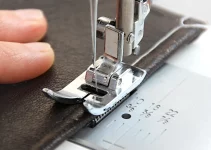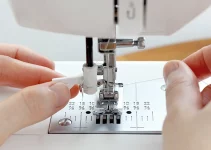If there’s one blunt statement that we can make right from the beginning of our sewing vs knitting vs crocheting comparison is all these three occupations are completely different.
Sewing, knitting and crocheting are awesome occupations for creating both beautiful and very practical objects but each of them requires totally different tools and different techniques. Out of all three, sewing is the one that stands apart the most.
Two of them, meaning sewing and knitting, use needles to make beautiful creations. But the needles for sewing and knitting are as different as makeup brushes and wall paint brushes. Makeup brushes are small and delicate as opposed the very big wall paint brushes.
Sewing involves very small needles, while the ones used for knitting are longer than my hand.
As for crocheting, it’s done with crochet hooks, which are completely different from knitting needles. What knitting and crocheting have in common is that both require yarn as materials for projects.
Check out my recommendations for the best sewing books if you want to learn more about sewing and the many various project we can use it for, either by hand or by employing a sewing machine.
Sewing vs Knitting vs Crocheting: the Biggest Difference
Besides the different instruments that I’ve mentioned briefly in my introduction, in the end, the main difference remains in their methodology and the materials they use.
Sewing stitches fabrics together

At its basis, sewing just doesn’t create clothes from yarn. It stitches fabrics together for making clothes, mending, pillow cases, curtains, bed sheets, quilts, and everything else you might think of. Even shoes.
The definition for sewing is that it is the craft of fastening or attaching objects using stitches. Sewing needles and thread are used for that purpose.
If you want to learn about hand sewing, check out my short guide on how to tie off a stitch.
Knitting and crocheting create objects from yarn

On the other hand, knitting and crocheting aren’t methods of attaching objects using stitches.
Knitting and crocheting are methods that manipulate yarn in order to create garments, fabrics, textiles.
These two activities actually create objects or fabrics from balls of yarn, while sewing certainly doesn’t involve any of that.
Knitting involves continuously interlinking or knotting a series of loops of yarn using very big needles.
Crocheting involves using a hook to create fabric from loops of yarn. It’s called a crochet hook. An interesting info is that if you don’t have a crochet hook, you might consider using a resized chopstick. I wouldn’t recommend it but I just wanted to let you know about it.
Thus, the main difference between knitting and crocheting is the instruments used for manipulating yarn to create fabric, textiles and whatever garments or objects you want.
Another big difference is that, in the case of knitting, if you drop a stitch it can cause your creation to unravel. It’s important to know how to fix a dropped stitch but we’re not here to talk about that.
Surprisingly, when we’re referring to crocheting, the drop loop stitch is actually a very unique crochet stitch. It certainly doesn’t mean the same.
Out of these two, knitting is the more complex one because it has multiple active loops. Crocheting has only one.
Sewing doesn’t create from yarn, it just attaches fabric together using stitches. But it doesn’t create the fabrics.
We can say that the one with the biggest differences in our sewing vs knitting vs crocheting comparison is sewing. It’s the odd one out.
Sewing vs Knitting vs Crocheting: What they’re Used for
The main thing they have in common is that these three activities are fascinating methods of creating clothes and many other objects.
All three can involve immense degrees of creativity and all three can help people create beautiful objects. Or they can just serve a very practical purpose.
What we can use sewing for
We can use sewing for anything, from replacing a missing button to fixing up old clothes in order to prolong their life, to creating our own bed covers, clothes, and the list can go on indefinitely.
We can choose to do it by hand if it’s something simple and fast or we can use a sewing machine for more time-consuming sewing projects.
What can we knit?
We can knit scarves, hats, gloves, socks, fluffy sweaters and ponchos, beautiful decorative pillowcases, blankets, slippers, phone covers, bags, dresses, decorative objects for the house, etc.
Knitting is amazingly versatile, it’s really limited by our imagination.
In my article answering the question is acrylic itchy I also talk about crocheting or knitting with acrylic yarns.
What can we crochet?
We can crochet toy animals, bags, hats, scarves, pillows, fruit bowls, bookmarks, blankets, pillows, hoodies, sweaters, dresses, cardigans, slippers, socks, etc. Once again, the options are plenty.
Knitting and crocheting also share pretty much the same objects that can be realized through these two methods. They’re the two similar ones in our sewing vs knitting vs crocheting comparison.
Check out my reviews for the best fabric stiffeners if you want to learn even more about what we can make with crocheting.
Sewing: short intro
The simplest definition for sewing is that it involves stitching two fabrics together through stitches. It can be done by hand or by machine.
As I’ve already mentioned, the major difference in our sewing vs knitting vs crocheting comparison is that sewing doesn’t involve creating fabric or textile or objects from yarn.
It needs the fabric to create the objects by stitching them together through needle and thread.
The needles are tiny, very sharp, and thread is fed through the needle’s eye. That’s how the stitching is done in its most basic form.
A needle and a thread are the simplest components for sewing done by hand.
A sewing machine will come with the needed components. The needles for sewing machines are standard so, if you need replacements, you don’t need to search for needles by models. All you have to deliver is the thread and the fabrics.
Hand sewing and sewing machines
As I’ve already mentioned, there are two options for sewing: making the stitches by hand or doing the stitches with a sewing machine.
I don’t need to tell you that doing it with a sewing machine is so much faster than hand sewing. There isn’t even a comparison between them.
However, besides reducing the number of hours you have to spend sewing and saving your hands from serious cramps, sewing machines will always have one major advantage over our hands: using a machine means more precision, straighter lines.
Hand sewing is certainly more appropriate for those who have a long history of knitting.
Did I mention knitting just because we’re discussing sewing vs knitting vs crocheting? No. I mentioned it because people who have knitted for years are used to putting in long hours and many days until the product is finished.
Thus, besides being confident that you can sew in straight lines, you must also have a lot of patience for projects that will take days to finish.
However, I imagine that the satisfaction will be immense.
I’m always relying on my machine because I’ve used one since I was a child. I’m not confident in my abilities to hand sew something more complicated than replacing a missing button. In my case, I will always choose sewing machines.
Knitting: short intro
Knitting is done with knitting needles. These are a lot larger than the ones used for sewing.
There are also various needles you can use, depending on the type of yarn that you’re using for knitting your objects. They’re categorized based on diameter.
Heavier yarn will require a larger knitting needle, meaning one with a large diameter.
The size of knitting needles is measured in mm (millimeters) in the metric system. They range from 2 mm, the smallest, to 10 mm, the largest.
In the US, the size of knitting needles is measured in numbers. The 2 mm diameter corresponds to the 0 size in the US. Size 15 in the US is the equivalent of a 10 mm needle in the metric system. Thus, we get sizes from 0 to 15 in the US.
However, you’ll also come across US 17 (12 mm) or even bigger. It really varies.
In terms of length, the standard size is about 14 inches.
Beginners can start off with 10-inch knitting needles of medium size/diameter, like size 7.
Metal knitting needles are the best because they offer faster speeds. They are usually made from aluminum but brass and nickel can also be used as materials.
However, beginners should first use bamboo or wooden needles because the stitches don’t slide off of the needles as fast as they do with metal.
Knitting components
Thus, we can sum up that the basic components for knitting are: knitting yarn and 2 knitting needles.
For creating the loops, two knitting needles are used at all times. If your mother or grandmother used to knit, I’m sure the clinking of the needles will be like a song to you. It is to me.
If we want to become more adventurous in our projects, we might need the following components besides knitting yarn and needles: crochet hooks, stitch holder, safety pins, needle gauge, circular needles, darning needles, buttons, small sharp scissors, scissor sharpeners, etc.
Crocheting: short intro

For some people, learning crocheting first helps them transition to knitting afterwards. You could stick just to crocheting and still be able to create an immense variety of projects.
Knitting and crocheting pretty much can create the same things. Thus, if you only learn to crochet and can’t handle the more complicated knitting, you’ll still be able to create a wide array of objects, be it decorative objects for the house, toys, blankets, bags, clothes, etc.
Crocheting is less complicated and harder to mess up. There’s no fear of dropping a stitch and risking your knitting to unravel. That’s a big advantage.
The simplest components for crocheting are: crochet yarn and a crochet hook.
Crochet hooks also come in different sizes.
In the metric system, for aluminum hooks, sizes start at 2 or 2.25 mm. In the US, that can correspond to the letter B or the size 1.
Usually, 2 mm or 2.5 mm B/1 hooks are used but you’ll also need size H/8 5 mm if you want to make blankets or scarves. It depends on your project.
Just one hook is used for making objects. The index finger on your free hand will hold the yarn. The hook goes in your dominant hand. The difference is that knitting is done with 2 needles.
Sewing vs Knitting vs Crocheting: Which Should You Learn?
It depends on what you’re trying to create and what your tastes are.
If you enjoy the look of yarn or wool and how the final objects end up looking, you’ll want to learn either crocheting or knitting. Some start with crocheting and then move up to knitting but you might end up being satisfied just crocheting.
On the other hand, if you’re more concerned with patching up old clothes, altering existing or newly bought clothes, replacing missing buttons, then you’ll want to learn to sew.
For some, sewing will be more useful. For others, knitting or crocheting is the perfect hobby.
All in all, I hope you enjoyed my short discussion on sewing vs knitting vs crocheting and maybe you’ll have an easier time deciding which is the best for you.




